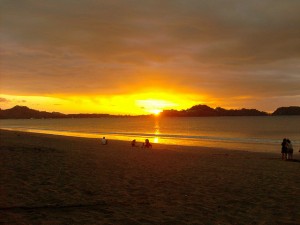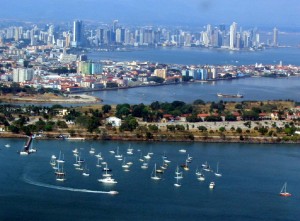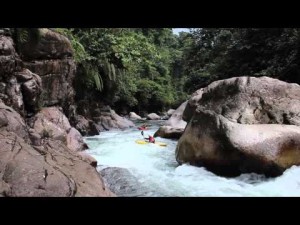
Belize is well-known among tourists for its beautiful beaches, excellent fishing, Mayan ruins, coral reefs, and tropical climate. But not for its medical care.
At least, not yet.
Plans are currently underway for this Central American country to expand its already-thriving tourism sector to include another industry that is gaining popularity across the globe: medical tourism.
What is medical tourism?
Medical tourism, also called health tourism or medical travel, involves traveling to another country to seek medical treatment or health care.
Patients, often from the United States, Canada, or European countries, venture to international destinations where specialized or elective procedures can be obtained at a much lower cost than in their home countries.
Some commonly sought procedures are joint replacement, heart surgery, weight reduction surgery, and cosmetic procedures. Among the leaders in this $100 billion industry are countries such as Thailand, India, South Africa, and–more locally–Brazil, Costa Rica, and Panama.
Medical tourism dates back as far as the ancient Greeks who left the Mediterranean and ventured to Epidauria near the Saronic Gulf, which was said to be the sanctuary of Asklepios, the god of healing. Many later Greeks and Egyptians followed suit, traveling to baths and hot springs in the name of better health.
The practice has continued in recent centuries as Americans and Europeans have flocked in increasing numbers to health spas and sanitariums. Today, the medical travel experience comes complete with an agency that can arrange for all aspects of the patient’s trip, including airfare, hotel accommodations, and even the procedure itself.
What is the current status of health care in Belize?
While Belize certainly knows how to attract tourists, its health care industry may have some work to do before it can compete with even some of its Latin American neighbors. The cost is certainly low enough, with a hospital stay running around $7.50 per day and laboratory fees hovering around the $5 range.
However, the number of doctors and medical facilities is limited. There is approximately one physician and one hospital bed for every 1,000 Belizeans, one of the lowest concentrations in the area. Both private and public sector facilities exist. However, over half of them are located in the Belize City area.
With such a shortage of medical facilities and personnel, it’s often difficult to find services beyond the most basic care. As a result, many residents currently travel to Mexico for anything other than routine procedures. In contrast with the availability of medical care, the quality is quite good.
Many of Belize’s doctors were trained abroad and include volunteer doctors from countries like Cuba. The country currently has no medical laws or regulations and requires no international certifications. However, a series of reforms prompted by the Ministry of Health in the 1990’s has done much to improve the health care system overall.
What makes Belize a good candidate for medical tourism?
Among the tremendous advantages for Belize as it prepares to take the leap into medical tourism are its proximity and familiarity to the U.S. Just a short flight away from hubs such as Miami and Houston, Belize is the only country in Central America that has English as its official language.
In addition to having doctors who speak their own language, Americans are also sure to be put at ease by the friendlier and more compassionate bedside manner of Belizean medical professionals.
Another benefit is the fact that most lodging in Belize already embodies an atmosphere that is very conducive to healing, being made up of mostly small inns with no more than a dozen rooms. This tranquility, coupled with the low cost of treatment and a feeling of home, are an excellent recipe for recovery.
What can Belize hope to gain by emerging into the medical tourism industry?
More investment in its health care system will naturally only continue to lower the cost and improve the quality of the country’s already affordable and reliable medical treatments and facilities. The sparse density of hospitals and physicians would drastically change once the country began treating thousands more patients, and the availability of specialized care would also increase.
The plan promises a tremendous boost to the country’s revenue and the employment of medical professionals, such as nurses, technicians, and medical assistants. This growth of the health care industry will also fuel the growth of tourism in general. An influx of patients seeking medical treatment will generate the need for additional taxi drivers, hotel and spa workers, and tour operators.
What are the next steps for Belize?
While the push for medical tourism is being driven largely by the Inter-American Development Bank (IADB) and the Belize Trade and Investment Development Service (Beltraide), both the Ministry of Health and the medical community are heavily involved in the planning stages.
A major concern is the lack of integration of Belizean doctors and health professionals, since the country has already been opening its doors to foreign-owned facilities. At workshops held in the fall of 2012, doctors were assured that those plans and permits had been put on the back burner until the country’s own domestic plan had been implemented.
Among the first steps in the process will be decisions regarding the implementation of laws and regulations. Hospitals will have to undergo the necessary certification processes, which may require them to modify some of their current practices. Local doctors would also need to be trained in new treatments and procedures to bring them up to par with their competitors in the medical tourism industry.
Even those on the periphery of the proposed health care operations would likely be educated in areas such as first aid treatments and cardio-pulmonary resuscitation (CPR). Future medical travelers to Belize could benefit from the added peace of mind of knowing that even their tour bus driver and hotel receptionist could aid them in the event of a medical emergency.
Of all of the cities in Ecuador, Cuenca is arguably the most charming with its cobblestone streets, old-world cathedrals, colonial parks, and mountain vistas. In Cuenca, there is never a lack of things for an expat to do over a weekend. We’ve rounded up five to get you started.
1. Eat Lunch at the Inca Ruins of Ingapirca
Just a two-hour drive outside of Cuenca is Ingapirca, the largest Inca ruins in Ecuador. As you explore by foot, take notice of typical regional handicrafts, including pottery, leather goods, and more. Many hotels offer guided tours to the ruins, known for its many stone structures surrounding the prominent circular sun temple. Find a comfortable seat and watch craftsmen weave Panama hats while you enjoy a typical Ecuadorian meal.
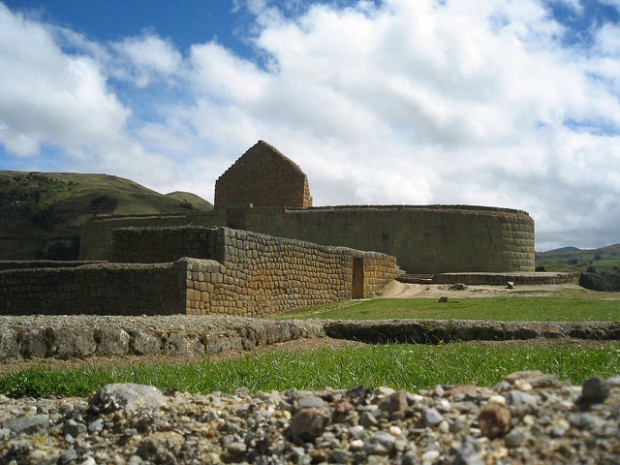
Inca stone ruins of Ingapirca, Ecuador
2. View Cuenca from Atop the Mirador de Turi
For an impressive view of Cuenca, take a taxi south of town along Avenida Solano to the stark white Church of Turi, that sits high on a hillside in the southern suburb of Turi. The views are especially grand on the holidays and in the evenings when all of Cuenca’s churches’ steeples and domes are lit throughout town.
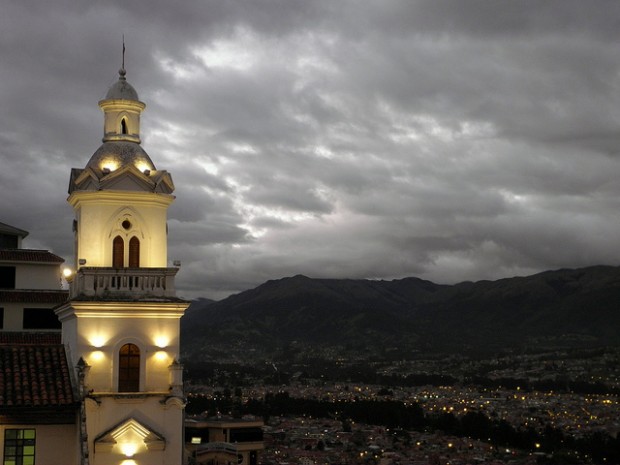
See Cuenca from atop Mirador de Turi.
3. See a Shrunken Head at Museo Pumapungo
Cuenca’s most important museum, Museo Pumapungo is home to five rare and eerie tzantza (shrunken heads) from the Shuar culture of the southern Oriente of Ecuador. Take your time, the museum is a great place to take in Ecuador’s vast cultural offerings where you can see traditional costumes of the country’s indigenous cultures, to Afro-Ecuadorians from Esmeraldas province, along with the cowboy-like montubios (coastal farmers) of the western lowlands.

See a shrunken head at Cuenca’s most important museum, Museo Pumapungo.
4. Take a Hiking Tour of Cajas National Park
With over 250 lakes and a natural abundance of flora and fauna, Cajas National Park is a popular hiking location at the doorstep of Cuenca. Offering all types of hiking grades, up to 12,000 feet, the park operates in all types of weather conditions, so be prepared. But if you need to get out of the city for a bit, it is a perfect day-long escape into nature.

Day hike the Cajas National Park.
5. Take a Postcard-Worthy Picture of the Catedral de la Inmaculata Concepción
Make certain to charge your camera for the focal point of Parque Calderón, Catedral de la Inmaculata Concepción, with its signature twin blue domes that have become the city’s hallmark symbol. The massive church whose austere marble interior took nearly 80 years to complete from its 1885 start date has beautiful stained glass windows and is particularly compelling during an evening service.
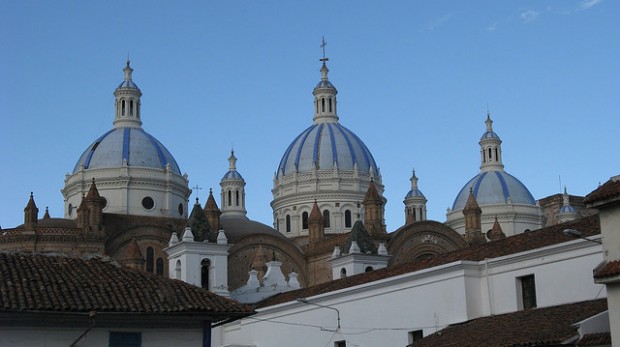
Take a photo of Cuenca’s most famous blue domes.
Did we miss your favorite spot in Cuenca? Let us know where you spend your weekends!

Cuenca, Ecuador photo by Jonathan Hood
When considering relocating to Latin America, many would-be expats quickly narrow their search down to the countries of Ecuador and Panama. And why wouldn’t they?
Ecuador has topped out International Living’s list of best places to retire for five years running, with Panama always following closely in the second or third spot. This list is based on an index of different factors such as climate, cost of living, culture, and many more. However, much of this criteria is highly subjective. The hot, humid climate you enjoy could be someone else’s idea of misery. Likewise the Burger King on the corner might be a welcome sight to some, but for you it might evoke the very feelings that prompted you to leave behind the cookie-cutter culture of the States.We’ve outlined some of the major differences between the two countries below, but don’t take our word for it. The best decision-making tool is your own observation. Plan a trip, and check things out for yourself.
Cost of Living
In this category, the advantage goes to Ecuador. In most parts of the country, you can easily get by on about $1,200 per month, including rent. This number gets even lower the further you venture into the rural areas where monthly rent can run as low as $150 per month. Combine that with an average cost of $1.90 for a four course meal, $1.50 for a gallon of gas, and the help of a domestic servant for a mere $10 a day. While it is possible to get by on the same $1,200 in Panama, it would be with a standard of living that more closely resembled that of the locals.
Real Estate
While Ecuador wins this one for its low cost homes, Panama may have a slight edge when it comes to the ease of the entire process. New homes in Ecuador are well below the $100/square foot price. That’s half the price of comparable homes in Panama, although the construction is different. Homes in Ecuador are built of cement and red clay.
The home buying process is easier in Panama, where international banks are quick to offer financing to foreign residents. Closing costs are twice as high in Panama (around 6%). However, property owners in Panama may be exempt from property taxes for a number of years if the home is their only residence.
Transportation
The infrastructure of Panama closely resembles that of the U.S., and its roads are much more well-maintained. Other than that, there’s little difference between the two countries. Ecuador offers several options for public transit, including buses and taxis, that average around $1 per hour. However, they may not be the safest options (See Safety below.) Panama offers similar modes of transportation for a slightly higher premium. Both countries offer convenient direct flights to several U.S. hubs from a few key cities.
Health Care
While health care in both countries is better than you’d expect, the quality may be slightly higher in Panama, particularly in David and Panama City. Panama boasts many private hospitals with English-trained and English-speaking doctors. In both countries the cost is lower than U.S. health care, up to 90% lower in Ecuador where doctors will even make house calls for less than $25. Both countries also offer a variety of health insurance options for foreigners.
Familiarity
Now here’s where personal preference really plays a big factor. While we can’t say which countries earns the most points in this category, we can tell you which one most closely resembles the culture of the U.S. It’s Panama. With a much larger and more established expat community, Panama will initially feel the most like home. It’s up to you to decide whether that’s the atmosphere you’re seeking.
Both countries use the U.S. dollar, so there’s little risks associated with currency exchange. English is widely spoken in both, although in Ecuador it’s largely confined to touristy locations and international business areas. Both are also home to many U.S.-based restaurant chains and other franchises. Modern conveniences are found in both, although internet service is reportedly much better in Panama. It’s true in both countries that communication is more accessible the closer you are to the larger cities.

Boquete, Panama photo by Ken Mayer
Climate
While this factor also depends greatly on your own personal taste, most will probably prefer Ecuador for its more temperate and varied climate. Panama is mostly hot and humid everywhere with large amounts of rainfall, particularly in May through December, although it’s slightly lower on the Pacific coast than the Caribbean side. The only real difference in the country’s climate is in the higher elevations where the temperatures and rainfall both decrease. Some areas may see temps in the 50’s versus the 84 degree average near the coast.
Ecuador experiences a more diverse climate across its four main regions. The mountainous Andean Sierra boasts average temperatures of 75 degrees by day and around 60 at night. With a lot of sunshine, 12-hour days, and relatively low humidity, its climate is considered by most to be nearly perfect. Ecuador’s coastal region and the Amazon rain forest more closely resemble the climate of Panama: hot and humid all year with temps ranging from 80 to 95 degrees and year-round rain. The Galapagos Islands have much milder temperatures and less rainfall.
Culture
While Ecuador and Panama both have plenty of cultural attractions, the edge here goes to Ecuador. While both countries boast many activities and forms of entertainment, those in Ecuador are often more authentic and less Americanized. With over 28 indigenous groups speaking more than 10 languages, evidence of the country’s heritage fills the marketplaces and festivals that abound in the South American nation. Panama is also a culturally rich country, but often in the form of museums and shopping districts.
Residency and Retirement Benefits
Panama wins this one, hands down. Requirements for a pensioner’s visa are similar between the two ($1000 per month income in Panama versus $800 in Ecuador). However Ecuador offers very few incentives for retirees. Panama, on the other hand, boasts a long list of discounts for those who qualify for its pensioners program. This includes savings of between 10 to 50 percent on virtually every category of goods and services including utilities, closing costs, entertainment, travel, and even health care. In addition, retirees can import up to $10,000 in household goods duty-free, as well as a personal vehicle every two years. And retirement in Panama has never been easier. Recent legislation has expanded its residency program to include individuals who may seek employment upon relocation, at least for citizens of the 47 “Specific Countries” on its list. This change was implemented to counteract the current labor shortage in the country.
Investment Potential
Buying property in both Panama and Ecuador can be a good investment. Since Ecuador generally offers more affordable options, its homes often have more potential for appreciation. However, even more advantageous than buying a home is the opportunity to invest in land in some of the more remote areas where expats are only just beginning to develop an interest. For those savvy enough to get in during the early stages, there’s much money to be made once development begins.
Investing in land won’t get you quite as far in Panama. Since expat communities there are more established, the lots are more expensive. You’d best build if you want to turn a profit. Panama does, however, have a much better rental market than Ecuador and more property management companies to provide assistance. Properties in Panama consistently experience higher occupancy and rent for a high premium.
Safety
While both countries have areas that are safer than others, Panama is definitely the safest overall. In fact it’s one of the safest in Central America, experiencing less violent crimes in a year than New York City does in a day. The country also saw the addition of the Tourism Police Force in 1992, which was specifically established to assist tourists in Panama City. Conversely, Ecuador is plagued with a murder rate of 19 people per every 100,000, four times that of the U.S. Even more alarming is the fact that much of the country’s violent crime occurs in areas heavily populated by tourists. Public transportation, especially taxis, are prime targets for criminals. It’s recommended that all taxis be radio-dispatched. Don’t just hail one on the street.
Schools
Panama wins again, with free public education that is a requirement for children ages 6 through 15. Investments are currently being made into the education system, to increase the number of educated adults in the workforce due to the labor shortage mentioned previously. Several good private schools also exist, many of which are bilingual. By stark contrast, Ecuador’s education system is in the bottom 50 world-wide. While it does have some private school options, most aren’t truly bilingual, only teaching English as a second language.
Things to Do
There is no shortage of activities in either Panama or Ecuador, and we would be hard-pressed to award this category to one country over the other. Both have options for exploring nature, such as whale or bird watching. There are also plenty of opportunities for adventure, like hiking or rafting. No matter what you’re into, you’re sure to find a place to enjoy your favorite hobby or perhaps develop a new one.
Costa Rica. There are very few countries that Wikipedia seems to have as much of a crush on. To sum up Costa Rica, Wiki talks about Costa Rica’s abolished army, that she’s on the list of 22 older world democracies, has a high human development rate and is ranked five in the world (first of all Americas) in terms of the 2012 Environmental Performance Index.
Wiki is head-over-heels, it seems.
Through all that flattery, there’re facts. Statistics. Awards. Let’s analyze the truth of what the search engine’s saying by looking to the latter of Costa Rica’s attributes today: to their environmental sustainability.
What Costa Rica Was Then (pre-2008)
Before the economic crisis in 2008, coastal urban development was booming. Urban property was valuable and life was good.
Then the crisis.
Property dropped up to 40% overnight.
What Costa Rica Is Now
Now, it isn’t the urban property that’s valuable as much as the rural. And no, I don’t mean for you to dust off your dungarees and become a coffee farmer (because this market also got hit by the recession; I hate to tell you, put those denims back in the attic!) but to notice the ecological value that has gone up instead.
Costa Ricans have been interacting with the land, and by doing so have increased its ecological value. Be it through reforestation, where value is given by the oxygen production and purification of carbon dioxide emissions, or the potential of wind farms in Guanacaste, these attitudes have changed the face of Costa Rica.

Photo: MD Verde
It is now the place where farmers voluntarily subject to environmental restrictions. It’s the place where the natural wealth in the ground is valuable, not just what you can build on it.
Having lived in places where by the end of the day you can see a cloud of smog looming over the city, this attitude is a literal breath of fresh air.
The best part about this all, of course, is that property prices are rock bottom for top notch locations. According to InternationalLiving.com’s Global Real Estate Index 2012 – which highlights the world’s 27 most attractive, and possibly lucrative, real estate hotspots outside the U.S. – Ecuador’s Pacific Coast came out tops. And that was just for its extremely low property costs and good quality housing stock.
Natural beauty, natural sustainability, at a great cost.
What’s stopping you?
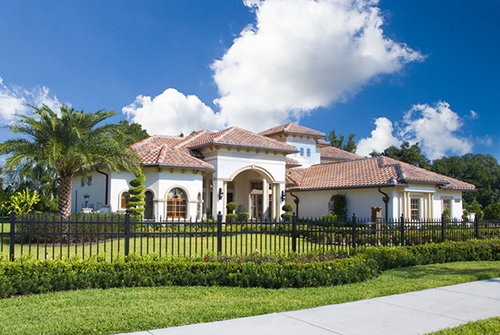
When it comes to real estate, there are always two choices: should you be renting or should you buy? Wherever you are in the world, whether New York City, Panama, or Ecuador: those two options never change. If you’re planning to start a new life overseas, you’re going to have to think carefully about which of them is going to be best suited to your upcoming overseas adventure.
The general wisdom is that buying is a better investment. When you buy a home, the money that goes towards paying the mortgage is money that you’ll be able to recoup if and when you decide to sell. However, if you’re thinking about emigrating or retiring to a tropics location like Panama or Nicaragua, you may find that renting is the best option, at least in the short term.
Why Should You Rent?
The first six months of any overseas move is a very crucial time. This is the time when you will either settle in to your new home and begin to thrive, or when you decide that it’s just not for you. Because of this, many sources recommend that for the first six months of your overseas move you rent. This gives you a bumper zone to decide:
- Whether the life in your new country is for you, and,
- Whether you have picked the right location within that country.
If you rent initially, you have the freedom to decide whether or not you’ve made the right decision with no long-lasting financial implications or responsibilities. If you decide that you want to go back home, or that you want to be in a different type of neighborhood, no problem! You don’t have to worry about selling up, and going through the extra costs of a move: you can just give notice on your lease and make your next move.
In addition to giving you greater flexibility during the first part of your big move, renting can have many other benefits for expats.
- You don’t need to worry about home maintenance. If you own your own home and something goes wrong: you’ll need to start the daunting process of looking for a contractor. If you’re renting, you’ll have a landlord at the end of the phone who will manage everything for you.
- You don’t need to manage the expense of importing furniture or buying new. You can rent a home already furnished, which takes away the trouble and the expense of deciding what to do about furniture.
- You don’t need to consider as many legal aspects. There are far fewer legal considerations to think about when you rent instead of buy. This can be a huge draw if you’re feeling daunted by the amount of paperwork involved in a move overseas.
- You don’t need to find local finance options to get a mortgage. Some of the most popular tropical locations such as Nicaragua, Ecuador, and Uruguay just don’t have local options available for financing. If you don’t have the means to buy a home outright, in some locations renting will be all that’s available.
The Bottom Line
When you’ve owned your own home for most of your life, it can be difficult to come to terms with the idea of renting. But the truth is that it’s often the best option for your move to the tropics: at least at first. Renting a place to live will allow you the flexibility to get used to your new surroundings and decide if the first place you’ve settled is where you want to remain long term.
The reasons to relocate to a haven overseas like Santa Fe, Panama, or Monte Verde, Costa Rica are wide and varied: but most people don’t do it primarily because they want to be a Latin American real estate owner! Remember that starting a new life in the tropics is more about the adventure than the investment opportunity! Why not stop buying, and start living?
If you decide to move forward with the renting process, you won’t need to do it all on your own. Think about using the services of a rental agent who is based in your destination country, and make sure you’ve considered these 14 pointers for renting abroad.
There are nearly 200 Mayan ruins sites you can explore in Mexico. Since the Maya of Mexico were the most advanced civilization of Mesoamerica, it’s worth putting a few of these ruins on your must-see list. Here are the top 5 Maya Ruins you should see when becoming an expat in Mexico.
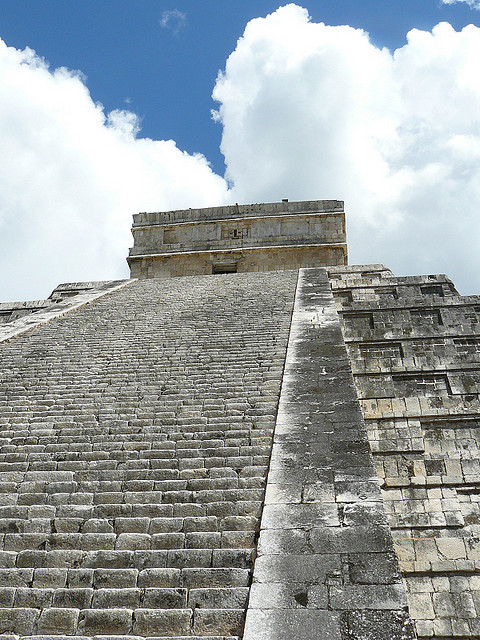
Chichén Itzá is Mexico’s most visited Mayan site.
1. Chichén Itzá – Take a day to tackle Mexico’s most visited Mayan Ruin.
Chichén Itzá is Mexico’s largest and by far the most tourist-filled of Mexico’s Mayan ruins. It features the Kukulkan Pyramid, named one of the new seven wonders of the world in 2007.
What to see: Carefully climb up one of the steep staircases of Kukulkan for a great view of the site.

Uxmal spans over 150 acres, and is home to one of the Maya’s most unique structures.
2. Uxmal – Home to one of the Mayan’s most unusual structures.
Spreading over 150 acres, Uxmal emerges out of harsh jungle land and is home to the massive Magician’s Pyramid. Its height and rounded sides make it one of the Maya’s most unique structures. What to see: Check out the site’s complex system of man-made wells. The structures sit at the entrance to the site, and to this day, mystify scientists.
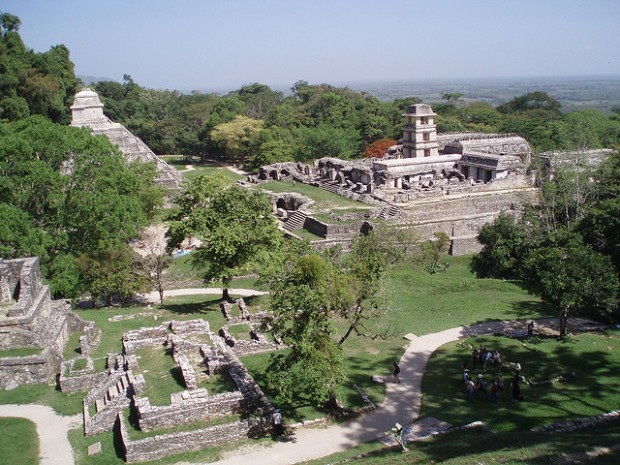
Palanque is known for its dense jungle growth and dramatic mountain setting.
3. Palanque – By far the most impressive of all Mexico’s Mayan ruins.
Palanque, surrounded by dense jungle forest in a dramatic mountain setting, its location in the savannah of Chiapas, is widely regarded as the most atmospheric and impressive of Mexico’s Mayan ruins. It was also named as a UNESCO World Heritage site. What to see: The Temple of the Inscriptions, named for the hieroglyphics found inside. Many of which are now on display at Mexico’s National Museum of Anthropology in Mexico City.

Spectacular Caribbean views await at Tulum.
4. Tulum – Where the Maya and Spanish Conquistadors first met.
Spectacularly located on a cliff overlooking the turquoise waters of the Caribbean Sea, Tulum is a Mayan settlement that flourished from around 1200 AD until the arrival of the Spanish.
What to See: Frescos located in The Temple of the Frescoes, directly in front of the Castillo, and used by the Maya as an observatory of the sun.
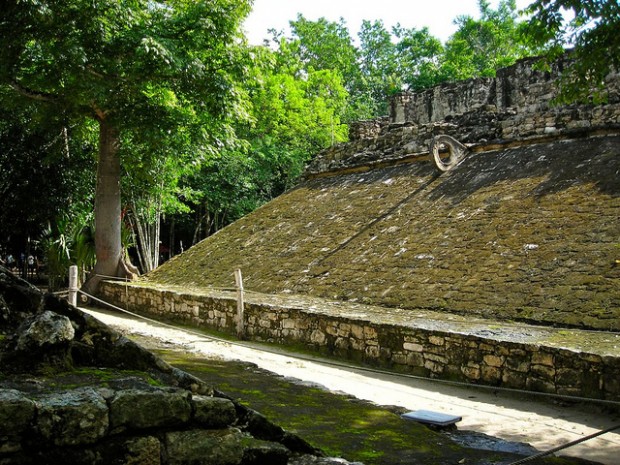
Ball court at Coba.
5. Coba – Home to over 6,500 structures to discover at your pace.
Much of Coba still remains to be excavated, but it is notable for its extensive system of ceremonial roads, remote jungle landscape and multiple pyramids, including the tallest in the Yucatan.
What to See: This vastly unexplored ruin is ripe for discovery through an intricate set of Mayan roads. In Coba, you are your own guide and can hike from mini-ruin to mini-ruin, but be warned, it takes about 3-4 miles of walking to each site and at least that many hours to explore most of Coba.
Want to learn more?
Here is an interview with Christopher Minster, Latin American History expert. He discusses the Maya, an ancient culture that developed reading, writing, and a complex society with Josh on Viva Tropical Radio. They also discuss their favorite ruins to visit.
Listen to the show
You can listen to the show using the player above or grab it and listen on the go via one of the following options:
The Panama 3 Count, where we bring you 3 Panama stories that you shouldn’t miss.

Photo: Bob Therina
1: Is Panama the Best Option in Central America?
Investment blogs and financial papers crow in unquestioning unison about the current and projected economic growth of Panama. As always, it’s tough to get a read on a place until you visit. And even then it can become harder to see the real picture.
2: What Donald Trump Can Teach You About Investing in Panama (Machine Translation)
U.S. billionaire Donald Trump has his sights set on expansion in Latin America and announced an additional investment of $100 million in Trump Tower Punta del Este in Panama, cementing his opinion that it’s a great time to invest in Latin America.
3: Is Privatization the Best for Panama’s Interior Airports? (Machine Translation)
The three interior airports of Panama will become privatized in a reversal of the decision to have them administered by Tocumen SA. The airports of David, Colon, and Rio Hato will be granted in concession to private companies instead. Meanwhile, budget Canadian airline Air Transat is in talks to offer flights to these same interior airports.
The Travel 3 Count, where we bring you 3 travel stories that you shouldn’t miss.
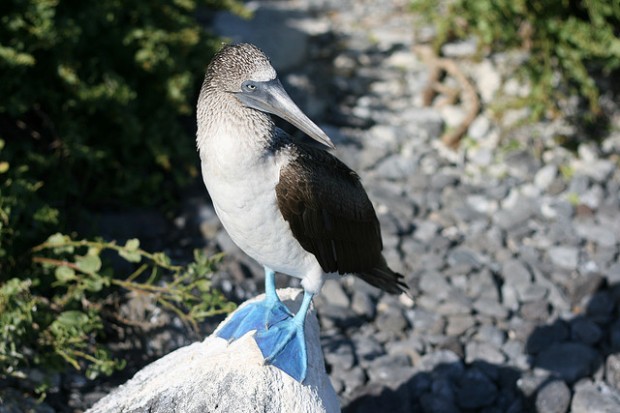
Ecuador’s Galapagos is a must see destination in 2013.
1. Destinations to Watch in 2013
First Up: Conde Nast Traveller’s destinations to watch in 2013 list includes some of Latin America’s gems. Here are the top Latin America destinations to watch in 2013.
- Panama. No longer just a place where ships pass in the night, Panama is the cool Caribbean destination of the moment.
- Mexico’s Mayan Riviera. The Mayan Riviera is set for a bounteous year in 2013.The vibe is deliberately hippy-chic, lo-fi by day and up-tempo at night and is a great place to stay for discerning travelers seeking barefoot luxury.
- Ecuador’s Galápagos Islands Galápagos is one of the most fascinating places on earth, an evolutionary melting pot. It’s already at the top of many wishlists, for the intrepid and for animal-lovers.
2. 21 Cheap Places to Visit… Where Does Latin America Come In?
Up Next. Want to travel, but don’t want to spend lots of money? These 21 cheap travel destinations let you get the most bang for your buck. Want to try it? Tim Leffel’s can help. His mission is to show cheapos how to find travel destinations they can afford.
Where is his favorite cheap spot in Central America’s? Ometepe, Nicaragua.
In Nicaragua, it’s a wide-open blank slate, because there isn’t much tourism outside of Granada and San Juan Del Sur. That means there are but a few nice hotels and restaurants and your main mode of transportation is mostly on chicken buses. But if you want cheap and exciting, Nicaragua is your choice.
3. 6 Must See Latin American Destinations
Finally: With over 7 million square miles to cover and 430 million people to meet between Central and South America, deciding where to start your Latin American adventure can be a little tricky, but with Bootsnall Travel Guide’s six must-see Latin American destinations, the planning just got easier.
- 1. Quito, the Amazon, and Cuenca – Ecuador
- 2. Rio de Janeiro and Iguazu Falls – Brazil
- 3. Lima, Cuzco, Lake Titicaca and Machu Picchu – Peru
- 4. Buenos Aires to Santiago via Bariloche – Argentina & Chile
- 5. La Paz, Sucre and more – Bolivia
- 6. San Jose to Panama City – Costa Rica & Panama
Adventure-lovers rejoice! These top sports are certain to deliver pure beach bliss, idyllic islands, curious creatures, and small towns packed with charm.
Granada, Nicaragua, has a lot to offer visitors. Rich in culture and history, Granada is a much sought-after travel destination. It’s a great jumping off point to tackle other little known, but adventurous day trips. Here are 5 to get you started.
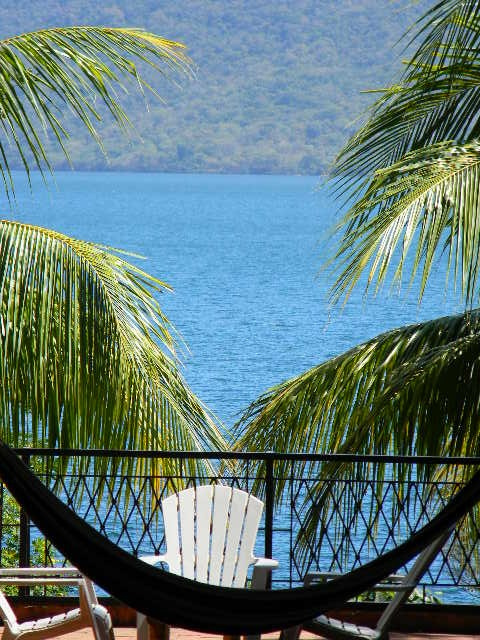
Take a swim in a crater lake, Laguna de Apoyo outside Granada, Nicaragua.
1. Take a Swim in Crater Lake
Granada is HOT. And though it’s on the shores of Lake Nicaragua, it’s nowhere that you want to swim. But head outside of Granada to Laguna de Apoyo, an ancient volcanic crater and rimmed by green hills. Along its edge are many hostels, most of which will allow you to use their beaches. Admission’s cheap, around 6 bucks.
2. Climb a Bell Tower for a $1
For just a buck, you can ascend Iglesia la Merced. Built in 1534, sacked and burned by Henry Morgan in 1670, then rebuilt, the church itself is pretty, but climb to the top for the single most spectacular view in Granada.
3. Hike an Active Volcano
Volcan Mombacho is the 4,400 foot volcano that towers over the city of Granada. It’s beautiful, green, and begs to be climbed. Though it’s active, it hasn’t erupted in over 500 years, so have no fear. There are three different trails to choose from, each varying in difficulty. The guide costs $15 for a group of up to 5 people, or $20 if you want your tour in English.
4. See a Stone Idol Carved in Bedrock
 About 15 miles south of Granada sits Zapatera, an extinct volcano surrounded by Isla el Muerto and a dozen or so other islets. These islands were enormously important to the Nahuatl people, who used them primarily as a vast burial ground and sacrifice spot. The sites of La Punta de las Figuras and Zonzapote are particularly rich in artifacts and have a network of caves that have never been researched. Ask around and seek out the petroglyphs carved into the bedrock beaches of Isla el Muerto.
About 15 miles south of Granada sits Zapatera, an extinct volcano surrounded by Isla el Muerto and a dozen or so other islets. These islands were enormously important to the Nahuatl people, who used them primarily as a vast burial ground and sacrifice spot. The sites of La Punta de las Figuras and Zonzapote are particularly rich in artifacts and have a network of caves that have never been researched. Ask around and seek out the petroglyphs carved into the bedrock beaches of Isla el Muerto.
5. Buy a Cheap Souvenir at a Local Market
Not too adventurous, if you speak Spanish, but Masaya Market is where the Nicaraguans shop. So most vendors only speak Spanish. It’s the best place to buy souvenirs in all of Nicaragua. With aisles upon aisles of Nicaraguan delights, and unlike in many souvenir markets, you barely have to bargain. It’s not a touristy spot, so you’re going to get a real feel of a true Nicaraguan market.
Further Reading on Granada
For an in depth look at Granada check out our Granada Starter Kit, a 64 page book packed full of info on Granada.

Panama City ranks as the cheapest place to live in Latin America.
A global study of the cost of living published by the EIU ranks the most expensive and cheapest cities in the world. While Tokyo continues to hold the top spot for the priciest places to live in; Panama City, Panama placed 8th among the world’s cheapest places to live.
The Global Survey Cost of Living, published twice a year by the EIU, compares hundreds of prices on 160 common products and services, such as food, drink, rent, utilities, education costs, and household items.
The 10 cheapest cities in the world
1. Karachi, Pakistan 2. Mumbai, India 3. New Delhi, India 4. Kathmandu, Nepal 5. Algiers, Algeria 6. Bucharest, Romania 7. Colombo, Sri Lanka 8. Panama City, Panama 9. Jeddah, Saudi Arabia 10. Tehran, Iran
Top 10 most expensive cities
1. Tokyo, Japan (up one place) 2. Osaka, Japan (up one place) 3. Sydney, Australia (up four places) 4. Oslo, Norway (up one place) 5. Melbourne, Australia (up four places) 6. Singapore (up three places) 7. Zurich, Switzerland (down six places) 8. Paris, France (down two places) 9. Caracas, Venezuela (up 25 places) 10. Geneva, Switzerland (down seven places)
The Economist Intelligence Unit’s Worldwide Cost of Living survey is a full service that enables human resources line managers and expatriate executives to compare the cost of living in 140 cities in 93 countries and calculate fair compensation policies for relocating employees.
The Panama 3 Count, where we bring you 3 Panama stories that you shouldn’t miss.
1: The PBS Guide to the History of the Panama Canal
For nearly a hundred years, the Panama Canal has stood for the triumph of technology over nature. But when it was built, at the dawn of the 20th century, it was simply an audacious gamble — a colossal engineering project, the likes of which the world had never seen.
2: The One Card You Need to Open a Bank Account in Panama
If all goes according to plan, Panama will soon roll out a simplified procedure for opening bank accounts in the country. The program will allow residents and legal foreign nationals with valid immigration cards to open bank accounts with a value of up to $1000.
3: Do You Recognize These Ways Panama Is Out Performing Costa Rica?
Tourism driven spending in Panama rose by 15% between 2010 and 2012 totaling $322 million in the last five years. The preferences of tourists include staying in the capital city, Panama Canal tours, Casco Viejo, and Panama’s interior, but spending was also increased in the conference and convention sector.
Ecuador has quickly earned its well-deserved reputation as one of the world’s top kayaking destinations. Its jungle boasts more rivers per square mile than almost anywhere else in the world. And the whitewater you will find among these runs includes everything from class II, for those just getting their feet wet in the sport, to class V for experts.
Why Kayak Ecuador?
- Great paddling when it’s cold and nasty in North America and the UK
- An amazing choice of rivers
- Warm water
- Sub tropical climate
- Exotic jungle setting
- Cheap accommodation, food, and transportation
- Easy logistics
- Clean, pristine rivers
The main place kayakers hang out is Tena, a pleasant, laid back, friendly town on the edge of the Andean Foothills and the Amazon basin and about 5 hours drive from Quito. There are about 8 different day runs here, all within an hours drive so most paddlers spend most of there time based in Tena.














